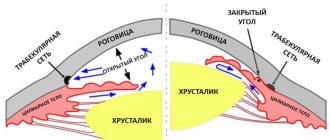Diclofenac eye drops 1 mg/ml 5 ml complete with dropper cap No. 1
Name
Diclofenac solution(s) 1 mg/ml in 5 ml bottle in set. with roof-drip in pack No. 1
Description
Transparent colorless or slightly yellowish solution.
Main active ingredient
Diclofenac
Release form
Eye drops
Dosage
1mg/ml
pharmachologic effect
Has anti-inflammatory and analgesic effects. In inflammatory processes that occur after operations, it relieves pain and reduces inflammatory swelling at the wound site.
Indications for use
Inhibition of miosis during cataract surgery; prevention of inflammatory processes associated with surgical removal of cataracts or surgery in the anterior segment of the eye; reduction of pain and photophobia after keratectomy during the first 24 hours after surgery.
Directions for use and doses
Adults: Inhibition of miosis during cataract surgery' Pre-operative: Instill up to five times within three hours before surgery. Prevention of inflammatory phenomena associated with cataract surgery or surgery in the anterior segment of the eye: Before surgery: instill up to five times within three hours before surgery. After surgery: 3 drops at the end of the intervention, then three to five times a day. It is not recommended to use the drug for more than 4 weeks. Reducing pain and photophobia after keratectomy within 24 hours after surgery: Within one hour before surgery, 1 drop 1-2 times, after surgery, 1 drop 2 times within an hour, then 1 drop four times within 24 hours after surgery . Children: No specific studies have been conducted. Dosing in the elderly: No dosage adjustment is required. Recommendations for using vials with a dropper cap: Before use, read this section carefully and follow the steps presented below in the text. Remove the bottle from the packaging. Position the scissors at an angle of 45 degrees to the lid, pick up its lower edge, and with an upward motion, remove the aluminum cap along with the rubber lid. Remove the dropper from the packaging and place it tightly on the bottle. Turn the bottle vertically to remove any air bubbles and wait a few seconds. In the case of a large bubble, return the bottle to its original position, and then slowly repeat the action, gently tapping the bottom of the bottle. Apply instillation by pressing the pipette with your index finger and thumb. Turn the bottle over and close the pipette with a special stopper. Recommendations for using dropper tubes: to reduce absorption, it is recommended to squeeze the eye canal for 1-2 minutes after instillation, pressing with your finger at the inner corner of the eye. Before using the medicine, remove the protective cap from the dropper tube and cut off the membrane of the body neck with scissors without damaging the threaded part. Wash your hands before instillation. Tilt your head back. Pull your lower eyelid down and look up. Turn the body of the dropper tube with the medicine upside down and with a gentle movement, pressing on the body of the dropper tube, drop 1 drop into the space between the eyelid and the eyeball. Do not touch the tip of the dropper tube to your eyelids, eyelashes, or touch it with your hands. Close your eye and pat it dry with a cotton swab. Without opening your eyes, lightly press the inner corner for 2 minutes. This will increase the effectiveness of the drops and reduce the risk of systemic adverse reactions. Wash your hands after use. After use, keep the dropper tube tightly closed.
Use during pregnancy and lactation
Contraindicated.
Impact on the ability to drive vehicles and other potentially dangerous mechanisms
After using eye drops, transient visual impairment is possible; the patient should refrain from driving or operating moving machinery until normal vision returns.
Precautionary measures
Do not administer parenterally, do not swallow. The drops should not be used as a peri- or intraocular injection. It is necessary to wash your hands thoroughly before instilling eye drops, avoid contact of the bottle or dropper tube with the eye or eyelid, and tightly close the bottle or dropper tube after use. The use of diclofenac sodium eye drops masks the signs of a bacterial eye infection, so the possibility of a sudden development of a bacterial infection during the use of the drug should be taken into account. With long-term use of the drug, it is necessary to regularly carry out preventive eye examinations, as well as monitoring intraocular pressure. Wearing contact lenses is not recommended during treatment. If it is impossible to refuse to wear contact lenses, they should be removed at least 5 minutes before instillation of the drug and placed back no earlier than 15 minutes after instillation. If, after using the drug, hypersensitivity reactions occur, such as itching, redness, an attack of bronchial asthma or sudden swelling of the face and neck, treatment should be stopped, immediate treatment is necessary. Non-steroidal anti-inflammatory drugs, including diclofenac, inhibit re-epithelialization of the cornea even with short-term use. The consequences of delayed corneal healing and the risk of infection have not been established. The use of NSAIDs increases the risk of bleeding from the eye tissue during surgery. It is recommended to prescribe the drug with caution to patients with an increased risk of bleeding or receiving drugs that may prolong bleeding time. When using NSAIDs in large doses for a long time, keratitis may develop. In some particularly susceptible patients, long-term use of the drug can lead to disruption of the epithelial barrier, thinning of the cornea, corneal infiltration, development of corneal erosion and ulcers, and corneal perforation. These complications can affect visual function. Corticosteroids are known to slow healing. Concomitant use of NSAIDs and steroids may increase the risk of impaired regeneration.
Interaction with other drugs
The combined use of diclofenac sodium eye drops with antiviral and antibacterial drugs in the form of eye drops and ointments, and ophthalmic corticosteroids is allowed. The break between applications should be at least 15 minutes to prevent leaching of the active substances with subsequent doses. When using Diclofenac eye drops simultaneously with ophthalmic corticosteroid drugs, the risk of corneal damage increases. Therefore, this appointment requires careful monitoring of the condition of the cornea.
Contraindications
Increased individual sensitivity to diclofenac and other non-steroidal anti-inflammatory drugs, as well as to any of the auxiliary components of the drug, a history of an allergic reaction or bronchial asthma caused by taking diclofenac, acetylsalicylic acid and other non-steroidal anti-inflammatory drugs, pregnancy, lactation, childhood ( up to 18 years old). With caution: epithelial herpetic keratitis (including history); diseases that cause blood clotting disorders (including hemophilia, prolongation of bleeding time, bleeding tendency); elderly age.
Compound
active ingredient: diclofenac sodium - 1.0 mg/ml; excipients: sodium thiosulfate, disodium edetate, propylene glycol, boric acid, potassium chloride, sodium hydroxide, water for injection.
Overdose
There is no information about cases of overdose.
Side effect
The frequency of side effects is given in the following gradation: very often (? 1/10); often (?1/100,
Storage conditions
Store in a place protected from light at a temperature not exceeding 25°C. Keep out of the reach of children.
Diclofenac eye drops 1 mg/ml 5 ml bottle with dropper cap No. 1
International nonproprietary name: Diclofenac/Diclofenac Synonyms Diclogen, Diclo-F, Clodifen, Medinac, Naklof Pharmacotherapeutic group Non-narcotic analgesics, including non-steroidal anti-inflammatory drugs. Drugs for the treatment of eye diseases. Composition Each ml of solution contains: active substance: diclofenac sodium 1.0 mg. ATX code: S01BC03.
Pharmacological action Has anti-inflammatory and analgesic effects. In inflammatory processes that occur after operations and injuries, it quickly relieves spontaneous pain and reduces inflammatory swelling at the wound site. Its anti-inflammatory activity is superior to acetylsalicylic acid, butadione, and ibuprofen.
Indications for use: inhibition of miosis during cataract surgery; inflammatory process after surgery, prevention and treatment of cystoid edema of the retinal macula after surgical removal of cataracts; - inflammatory process of non-infectious nature: conjunctivitis, keratoconjunctivitis, corneal erosion, post-traumatic inflammation of the conjunctiva and cornea, photophobia after keratotomy; - treatment and prevention of post-traumatic inflammatory process in penetrating and non-penetrating wounds of the eyeball (as an addition to local antibacterial and antiviral therapy).
Directions for use and dosage regimen: Local. To inhibit intraoperative miosis, instill 1 drop into the conjunctival sac for 2 hours before surgery with an interval of 30 minutes (4 times); immediately after surgery - 1 drop 3 times, then - 1 drop 3-5 times a day for the time required for treatment. To prevent cystoid macular edema, 1 drop 3-4 times a day for 1 month. after operation. Other indications: 1 drop 3-5 times a day, depending on the severity of the condition. The course of treatment is 1-4 weeks.
Special instructions The use of diclofenac sodium eye drops masks the signs of a bacterial eye infection, so the possibility of sudden development of a bacterial infection while using the drug should be taken into account. With long-term use of the drug, it is necessary to regularly carry out preventive eye examinations, as well as monitoring intraocular pressure. Wearing contact lenses is not recommended during treatment. If it is impossible to refuse to wear contact lenses, they should be removed at least 5 minutes before instillation of the drug and placed back no earlier than 15 minutes after instillation. Prescribe with caution to patients with a history of allergies. If the irritant effect is pronounced, you should stop using the drug.
Side effects When using the drug, local tissue irritation (burning, redness, blurred visual perception (immediately after instillation), swelling, pain, lacrimation), allergic corneal opacification (thorn), iritis is possible; allergic reactions: itching in the eyes, hyperemia, angioedema of the face, fever, chills, photosensitivity, skin rash (mainly erythematous, urticaria), exudative erythema multiforme; nausea, vomiting.
Contraindications Hypersensitivity to diclofenac and other non-steroidal anti-inflammatory drugs, as well as to any of the auxiliary components of the drug. With caution: bronchial asthma caused by taking acetylsalicylic acid, epithelial herpetic keratitis (including a history); diseases that cause blood clotting disorders (including hemophilia, prolongation of bleeding time, bleeding tendency); pregnancy, lactation, children (up to 16 years) and old age.
Interaction with other drugs The combined use of diclofenac sodium eye drops with antiviral and antibacterial drugs in the form of eye drops and ointments, and ophthalmic corticosteroids is allowed. The break between applications should be at least 5 minutes to prevent leaching of the active substances with subsequent doses.
Precautionary measures Impact on the ability to drive a car and potentially dangerous mechanisms: be careful when driving vehicles and engaging in other potentially dangerous activities that require increased concentration and speed of psychomotor reactions.
Release form Solution (eye drops) 0.1%, 1 ml in dropper tube No. 2; in a bottle of 5 ml.
DICLOFENAC (drops)
The party carries certain information.
Here is the complete composition of the drops.
Manufacturer: Moscow Endocrine Plant.
A few tips for potential users: - use only if prescribed by a doctor, and not determine your own diagnosis; - the storage place should be difficult to reach for children, protected from light, the temperature should not exceed 15 degrees, - do not freeze; — after opening the bottle, the drug can only be used for 1 month, this is its shelf life.
Instructions for using the dropper bottle are presented in pictures and with a step-by-step description.
On the end sides of the box you can see the date of manufacture of the drops - this is the current year, they are good until 2022, that is, for two years, and there is also a barcode of the country of origin - Russia.
The price is cheap, at the pharmacy they put it with a marker right on the box, 35 rubles, just for nothing.
The bottle nestled comfortably inside the box, hugging the folded instructions.
INSTRUCTIONS.
The attached instructions must be read before using the drops; we already know some of the information about them, but it also indicates their properties, indications and contraindications, and side effects. We can draw the first conclusion: Diclofenac drops are suitable for us according to the indicated indications, as an anti-inflammatory drug to relieve swelling and pain that are caused by the inflammatory process, so the prescription was made correctly.
DROPPER BOTTLE. It is made of transparent plastic, with a small label on which the name of the drops, their purpose, volume, manufacturer and expiration date are duplicated.
The cap on the bottle is convenient; the first time you turn it clockwise, the top of the neck should be punctured, but alas, after removing the cap, it turned out to be sealed, so I had to make a small hole using improvised means, and after the procedure was completed, the cap must be screwed back on so that the drops do not spill out.
We squeeze out a drop by pressing on the body of the bottle and it drops into the eye in doses.
Drops in a bottle are transparent, colorless and odorless.
TREATMENT AND RESULT. Following the doctor’s recommendations, we instilled 1 drop 4 times during the day every four hours, dropping it into the eye, trying to distribute it throughout the eye, while a slight burning sensation was felt, which went away after a minute, I think this is how it should be, this is a reaction to the treatment. The course of treatment lasted for two weeks: the swelling of the eyelids gradually subsided, the pain in the eyes almost disappeared, remained slight in the morning, sleep was restored, which means there is a result from the treatment. And after visiting the ophthalmologist again and extending the treatment for another two weeks, it was successfully completed. For the entire course it took us two bottles of 5 ml each and only 70 rubles.
Diclofenac eye drops 0.1% worked for us and we got an excellent result, I recommend it, but use it only after a doctor’s prescription, do not self-medicate. Health to everyone!


